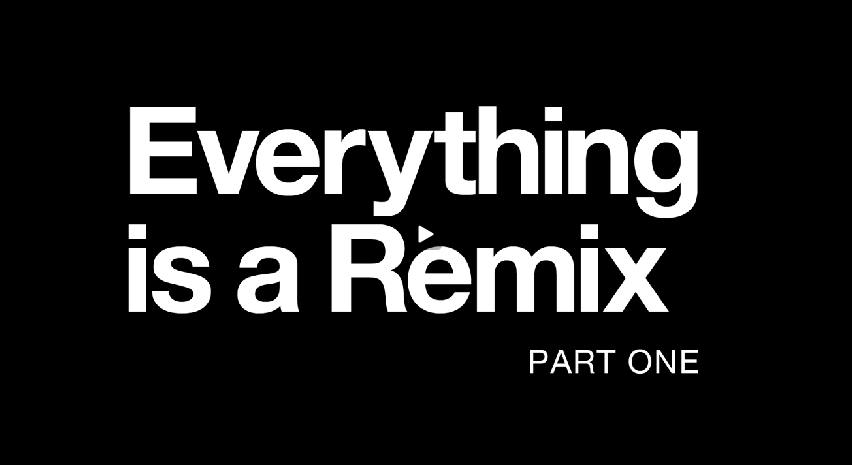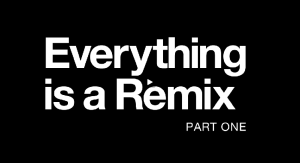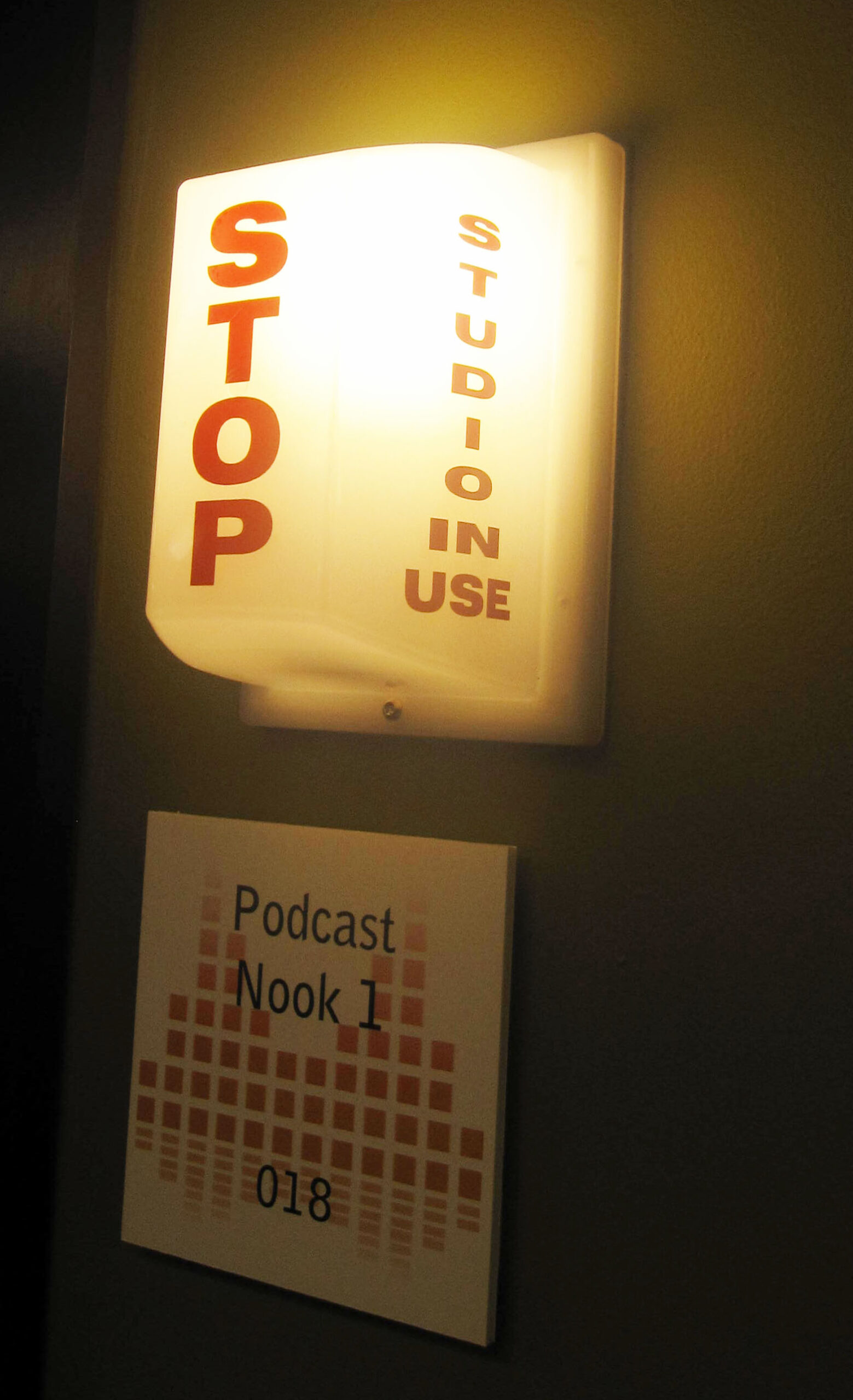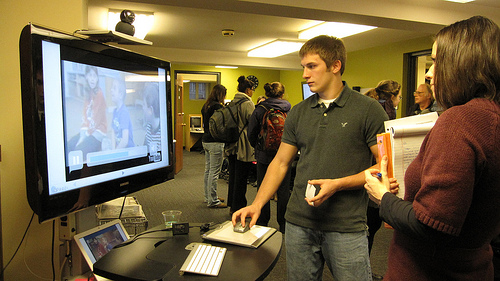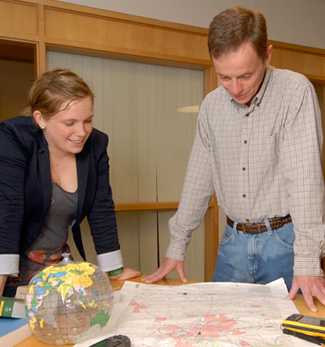Part 2 of the Everything is a Remix series focuses on film this time around. Films like Star Wars and Kill Bill are highlighted.
Author: BSL (Page 8 of 9)
 The Media Center was able to create two new podcast nooks and one large studio over the summer to accommodate the need for sound buffered areas for recording voice and music. People love using the rooms although we found it was hard to sometimes verify if the rooms were in use since there a no windows on the door. We certainly didn’t want to interrupt a recording in process so we invested in new lights that were installed outside the rooms so we could be sure when people were recording. Stop by the media center to check out the new addition and play with the technology in the recording booths!
The Media Center was able to create two new podcast nooks and one large studio over the summer to accommodate the need for sound buffered areas for recording voice and music. People love using the rooms although we found it was hard to sometimes verify if the rooms were in use since there a no windows on the door. We certainly didn’t want to interrupt a recording in process so we invested in new lights that were installed outside the rooms so we could be sure when people were recording. Stop by the media center to check out the new addition and play with the technology in the recording booths!
 Check out these YouTube Channels:
Check out these YouTube Channels:
Description
Comic Life is a program you can create comics with but it can be used in so many different ways that you may not have considered . Classes at Dickinson have used it for storyboarding, lab manuals, presentations and of course comics as well. It is a program that is easy and fun to use and allows students to be creative by having so many options available to customize their final piece. It is located in the Bosler Microroom (020) and the Media Center. It can also be downloaded from plasq.com to use as a trial version although it will leave a watermark on anything printed from it.
Audience
Faculty & Students
Type
Instructor Led-Hands On
Time
30 Minutes – In Class Time
Outcomes
- Learn to organize project into outline
- Migrate outline into visual form
- Understand fair use and where to locate Creative Commons images
- Understand basics of good graphic design and layouts
Want to know more? Contact mediacenter at dickinson.edu to set up a consultation. You can also get a sneak peek of what we cover in our training by looking over our Training Outline.
Examples
Professor Dave Ball-Graphic Narratives
In this English course Professor Ball has his students read a series of graphic novels and create one page comics in response to the reading. This class has been taught 3 times with a blog associated with each one to display the comic responses.

Professor Kristi Humphreys-Chemistry
Professor Humphreys had her students create one or two page comics describing common practices students must know to use equipment in the lab. The comics could then be combined to format a reference manual to use when doing experiments.
Professor Tom Arnold-Biology
Each student in his class on Metabolism was assigned a metabolic disorder that they had to research and present on. Half of the grade for the project was based on a 5-6 page manuscript with a detailed review of the chosen topic. Comic Life was used to create a graphic illustration to describe the disorder and used as the basis of the presentation. The presentation and graphic were each a quarter of the grade for the project.
 Description
Description
Although Powerpoint is widely used as the main slideshow program, there are interesting alternatives that can give your presentations a different style and depth. These also are good options for embedding multiple media elements. The two programs we train on are Prezi & Vuvox. Both are alternative slideshow programs but deliver the content in very different ways. These are online programs so they can be edited anywhere and can be left private or opened up for the public to view.
Audience
Faculty and Students
Type
Instructor Led-Hands on
Time
30-50 Minutes In Class Time
Outcomes
- Understand best practices in presenting
- Understand presentation formatting styles
- Ability to incorporate audio, video, images and text into a presentation
Sites
Prezi manual
Clean Slate
Text heavy
Examples
Professor Liz Lewis- Educational Psychology Class
View images from Professor Lewis’s student presentations here.
Prezi
Prezi is a flash based presentation program that is one large canvas where you add multiple images, videos and text. It doesn’t have traditional slides but instead you can pan and zoom across the canvas in any direction to quickly focus in on one element. The creator has the ability of programming the Prezi to follow along a certain path so that gives the feeling of a more traditional slideshow.
Vuvox
Vuvox describes itself as a collage and is a rectangular display where you can pan forward or backwards across the collage. Vuvox lends itself well to a very image rich presentation. It integrates all of the elements seamlessly and allows you overlap items to keep everything connected. It also has a cutout function which gives you the tool to cut certain sections out of image so it blends well into the next image, combining the two in a sense.
Gapminder
Instructional & Media Services has a full time GIS Specialist on our staff to support GIS projects in all disciplines. Our specialist, Jim Ciarrocca, is available for consultations on possible projects. Here are a few examples of past GIS workshops.
Introduction to GIS
GIS (Geographic Information System) is a way of capturing, analyzing, and displaying data in a spatial manner. While Google Earth may be able to perform some of these functions, ESRI, the GIS software supported on campus, allows for the entry and analysis of much larger and sophisticated data sets. Faculty in Geology and Environmental Studies are already using this software for their classes or research. This workshop will demonstrate how faculty from other departments across the curriculum can use GIS to display information spatially in a manner that is accessible for everyone.
GIS: Making Simple Maps
In this introductory workshop we will explore using geographic information system (GIS) software from ESRI to build a simple map. We will start with a predefined lesson and data set. Tasks will include layering the data onto a base map, classifying and symbolizing the information, adding a title and legend, and saving the finished map in a format suitable for publication.
Introduction to Spatial Literacy
Understanding how to think about problems and concepts in a spatial context is a fundamental skill that is not well taught in the American educational system. Often referred to as “Spatial Literacy”, this type of thinking focuses on understanding the importance of geographic space, and the relationships formed by this space. Spatial Literacy is not a stand-alone subject, but rather it is a way of thinking that cuts across all fields of studies, and is becoming increasingly important as a necessary skill for liberal arts graduates across all disciplines. A powerful technology for engaging spatial thinking is called Geographic Information Systems (GIS), which provides sophisticated tools for collecting, managing, analyzing, and visualizing spatial data.
Google Earth allows users to embed and display information on top of a representation of the world created via satellite photos. In this workshop we’ll go over basic navigation of the Google Earth interface, as well as Google sponsored layers, including historical maps and government data bundled with the latest release of Google Earth. Finally, we’ll demonstrate how you can enter your own text and images, and then attach them to a location.
Instructional & Media Services supports a wide range of video projects in classes from many different disciplines. These projects don’t have to be big and involved to be effective and we work with each Professor to help find what the best level of technology is for their course and project idea. As with most projects, it is best to plan out a time line with smaller assignments due over time to ensure students are on the right track. This usually involves writing a short script or storyboard and also gathering some source material to submit prior to editing the final piece. Most people think of video projects as always using a camera but many projects use only still images that are panned & zoomed across to give the allusion of movement (ala Ken Burns). A narration is then added over the images to create the final video. IMS will set up a time to come into the class to train the students on the technologies needed. This may only be IMovie for a project that is using images instead of actual video. Otherwise, we may train on how to use & checkout our video equipment and how to use the higher level video editing program Final Cut Express. The Media Center is a the physical resource where the students will be able to work to complete their project while getting support from IMS staff.
Training Session Information
Audience: Faculty & Students Type: Instructor Led-Hands on Time 1 – 1 1/2 hours in-class time
Outcomes/Objectives:
Upon completion of this workshop, you will:
- Know how to use the software programs IMovie to record & edit video
- Have observed a variety of course related video examples.
- Know best practices to use when writing script.
- Be provided online resources to help you get started finding creative commons audio, video or image files.
Want to know more? Contact mediacenter at dickinson.edu to set up a consultation. You can also get a sneak peek of what we cover in our training by looking over our Training Outline.
Examples
Independent Study
Beautifully Fragile
Composting on Dickinson’s Campus
Threads for Thought
Professor Michael Fratantuono
Global Economy Course
Students were asked to create mini lectures about assigned topics. These videos serve as a supplement to the course as Professor Fratantuono can show these in place of some traditional lectures and promote additional discussion the topics. http://youtu.be/Art6Kw2xN6U
Professor Jim Hoefler-Policy Studies
Policy & Management Senior Seminar students compose DVDs for non-profit organizations in the local community. http://www.youtube.com/watch?v=QNQIcK5OGzQ
Professor Sherri Lullo-Asian Art History
Students were each assigned a piece of Asian Art held by the college’s Trout Gallery and used the Ken Burns effect to display images of the piece while telling the story of it’s history. Full list of videos can be seen here http://blogs.dickinson.edu/introartsofasia/files/2010/11/box.mov
Professor Ed Webb-Political Science
Students in his First Year Seminar course “Science Friction~Dystopian Visions”, were able to make a media project to post to the blogs they were maintaining during the semester. This was a great piece that Ellen Kaveevittayakun created. http://www.youtube.com/watch?v=ZaGTgFY_7K8 She also does a great job of creating a credits page. This is a perfect example of fair use mashup for education.
Chemistry
http://youtu.be/tTCLOe_2GXE http://www.youtube.com/watch?v=745DTlmvw5U
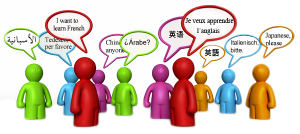 Description
Description
Dickinson’s Language Technologist, Todd Bryant, has been coordinating language exchanges for most of the languages for the past 8 years. Using Skype and a website for partnering language learners called The Mixxer he has been able to integrate skype exchanges throughout the language departments.
The partners can be any native speaker of our students’ target language who is interested in improving their English. The discussion is split into two 20-25 minute sessions. The first portion is in the students target language with the second portion in English. Faculty are encouraged to have students prepare questions beforehand and assign students a summary of their conversation as homework.
Audience
Faculty & Students
Type
Instructor Led-Hands On
Time
50 Minutes-In Class Time
Outcomes
- Talk with native language speaker for 20-25 minutes in each language
- Listening comprehension
- Cultural exchange
Want to know more? Contact mediacenter at dickinson.edu to set up a consultation. You can also get a sneak peek of what we cover in our training by looking over our Training Outline.
Examples
Overview of Skype exchange in Japanese course
Overview of how to set up a language exchange through the Mixxer
(iPOD broadCAST) An audio broadcast that has been converted to an MP3 file or other audio file format for playback in a digital music player. Although many podcasts are played in a regular computer, the original idea was to listen on a portable device; hence, the “pod” name from “iPod.” Although podcasts are mostly verbal, they may contain music, images and video.
Here at Dickinson, we have put the creation process into the hands of the students. Podcast projects have been effectively integrated into courses when students are assigned a particular topic to research. Often it is paired with a more traditional paper and the podcast serves as a public service announcement of sorts to make the information accessible & understandable to the general public. This also serves as an introduction to public speaking since the podcast must be delivered in an engaging, interesting manner to keep the listener connected to the topic. Dickinson professors & students have been podcasting for the past 5 years on any number of subjects. Any type of course has the potential for creating well written, informative & engaging podcasts. These projects are not limited to only upper level courses or specific disciplines. Podcasts have been created in First Year Seminars up to 400 level courses and in the humanities, social sciences & hard sciences.
Audience
Faculty and Students
Training Type
Instructor Led-Hands on
Time
45 minute in-class time
Workshop Outcomes
Upon completion of this workshop, you will:
- Know how to use the software programs Audacity, Garageband or IMovie to record & edit podcast
- Have observed a variety of course related podcast examples.
- Know best practices to use when writing script.
- Be provided online resources to help you get started finding creative commons audio, video or image files.
Want to know more? Contact mediacenter@dickinson.edu to set up a consultation. You can also get a sneak peek of what we cover in our training by looking over our
Examples
Quantum Connections
Topic: Time Travel
Very Creative Style-Role Playing
Professor David Jackson
Physics- First Year Seminar-Quantum Mechanics
Quantum Connections: Where we discuss some of the strange and fascinating features of Quantum Mechanics.
The Shoulders of Giants
Topic: The Square root of two
Complex topic described in interesting way so people can understand and connect with topic-good intro
Professor Dave Richeson-Mathematics
Course: Great Theorems & Ideas in Math
The “Shoulders of Giants” podcasts profile history’s greatest mathematicians.
Creative Geniuses & Their Rivalries
Topic: The Battle of the Currents
Storytelling style-Dark-Took different path than what most would have chosen to describe electricity
Professor Barry Tesman-Mathematics-First Year Seminar
Creative Geniuses & Their Rivalries: One could argue that most progress, in many fields of endeavor, has come about because of rivalry. Whether in science, art, or sports, recognition or competition to be first or best has been the driving force for many people. In addition, these people of accomplishment have led lives that one would not consider, in the words of George Bernard Shaw, reasonable.
“The reasonable man adapts himself to the world; the unreasonable one persists in trying to adapt the world to himself. Therefore, all progress depends on the unreasonable man.” – George Bernard Shaw
Moving at the Speed of Science
Topic: Commercial Space Travel
Fast, fun, engaging. Good use of sound effect (but not overused)
Professor Missy Niblock-Biology
Course: Writing Science News
Moving at the Speed of Science
Great Secular Jews in History
Topic: Albert Einstein
Well thought out. Great use of sound effects/music to evoke feeling of piece
Professor Ted Merwin-Religion
Course: Jewish Identity in a Secular Age
Great Secular Jews in History
Atlantic Slave Trade
Topic: Carolina Low Country
Great use of music, description to give mental picture.
Professor Jeremy Ball-History
Course-Atlantic Slave Trade
 Untold Stories of Disease and Disability
Untold Stories of Disease and Disability
Topic: Schizophrenia
Use of an interview clip. Public service announcement example.
Professor Dan Schubert-Sociology
Course: Sociology of Health and Illness
“Untold Stories: Raising Awareness about Disease and Disability” is a series of podcasts recorded by students in Professor Dan Schubert’s “Sociology of Health and Illness” class. Through research and interviews, the recordings give background on specific illnesses and how they affect those afflicted.
Sustainability-Red Bikes
ARTH 110: Introduction to the Arts of Asia
Topic: Japanese Print from Trout Gallery
Using narration over images. Created using IMovie & series of images from Trout Gallery of Creative Commons files.
Professor: Sheri Lullo-Art History
Course:ARTH 110: Introduction to the Arts of Asia
Kawase Hasui – Beppu Kankaiji
Professor Liz Lewis had her Ed Psych students create multimedia presentations using Prezi. They had 2 days of presentations in the Media Center and here is the photo archive of the great event.
